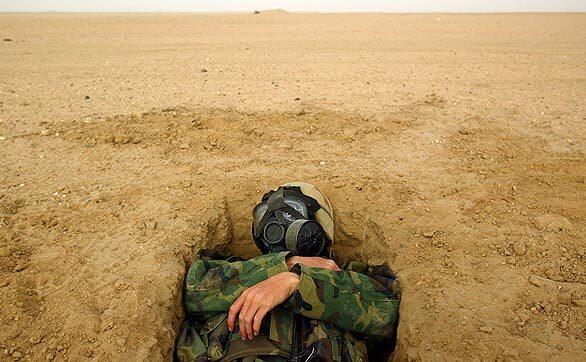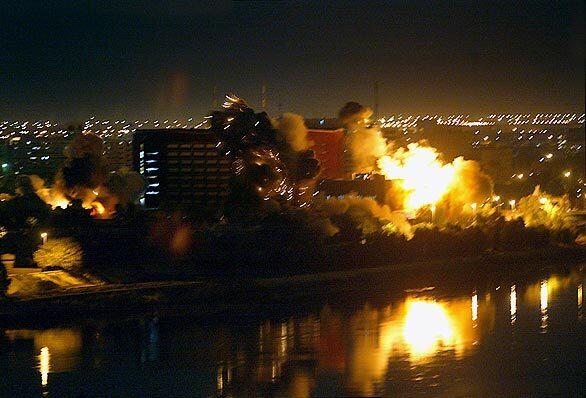
“Like a choreographed fireworks display, one building after another exploded in bright yellow flames, quickly smothered in clouds of dust and debris,” writes Times’ reporter John Daniszewski in his piece
Bombs rained down for a second night on the Iraqi Planning Ministry and other buildings in one of Saddam Hussein’s presidential compounds on the Tigris River in the heart of Baghdad. At the same time, coalition forces began a ground campaign, with U.S. and British troops sweeping into southern Iraq. (Carolyn Cole / Los Angeles Times)
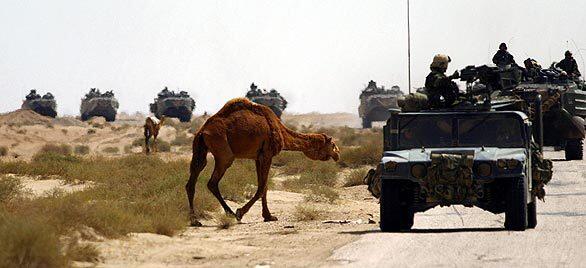
A camel surveys a convoy of U.S. military vehicles rolling through the Iraqi desert as they press almost unimpeded north toward Baghdad. Backed by a relentless barrage of air power, U.S. and British troops passed the halfway point, but were slowed by patches of Iraqi resistance and braced for heavier fighting. (Rick Loomis / Los Angeles Times)
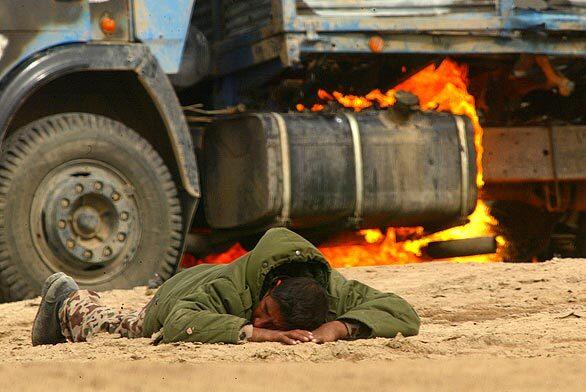
An Iraqi soldier, his vehicle ablaze behind him, surrenders to U.S. troops near Nasiriya in southeastern Iraq. Large numbers of Iraqi troops turned themselves in, but American troops faced some intense resistance as they continued their advance toward Baghdad. The city was pounded by airstrikes for the fifth straight day.
Advertisement
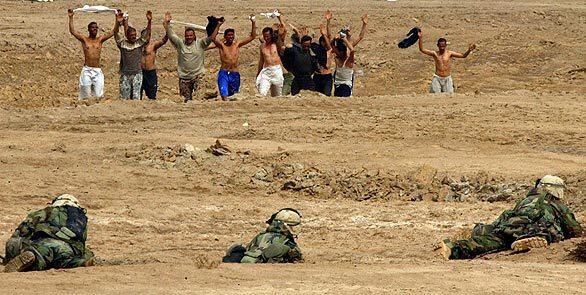
Iraqis surrender after a gunfight with U.S. troops. Guerrilla fighters sometimes posed as civilians and opened fire on U.S. and British troops, violating laws of armed conflict, U.S. officials said. Severe sandstorms stalled the push toward Baghdad. (Rick Loomis / Los Angeles Times)
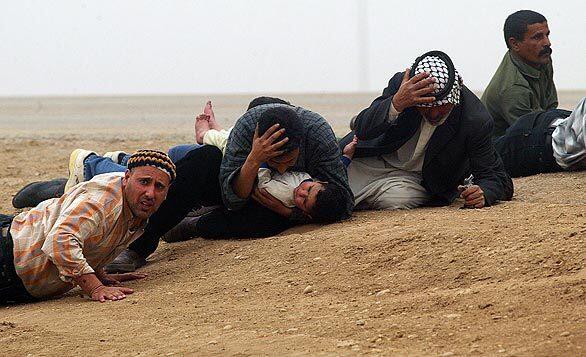
Iraqis, one carrying a child, lie on the ground on the order of American troops who stopped their vehicle as it approached U.S.-held territory. The men, who said they were fleeing from Baghdad, were ordered to turn back. One of them, far left, refused to return toward the capital and walked away into the brush. (Rick Loomis / Los Angeles Times)
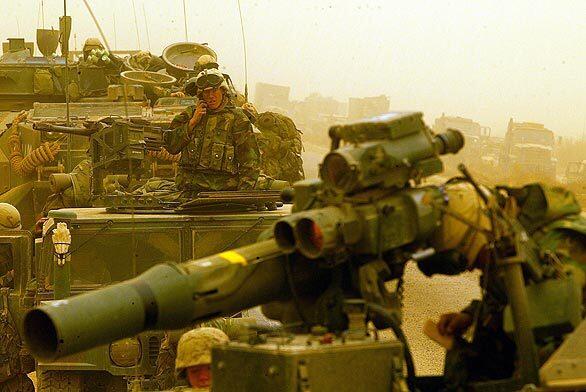
A Marine uses a radio while sitting out a sandstorm in southern Iraq. The blinding dust, with visibility reduced to 10 feet, forced a halt to some airstrikes. U.S. Marine and Army forces that were closing in on Baghdad were frozen in their tracks.
With U.S. Marines stuck in a sandstorm, what was public sentiment back home at this time? Read the Times’ article
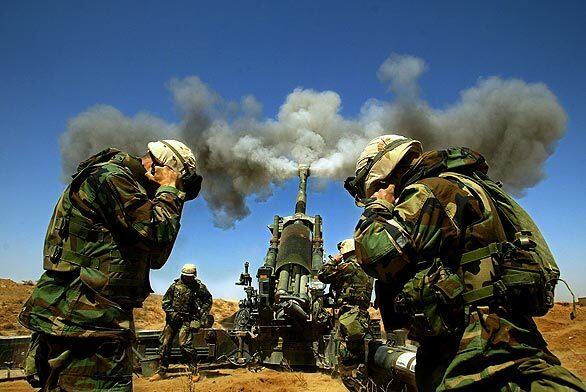
U.S. Marines shield their ears from the roar of a 155-millimeter howitzer firing on Iraqi positions south of Baghdad. The U.S. opened another front in the war, with a vanguard of 1,000 American soldiers parachuting into northern Iraq earlier in the day. (Rick Loomis / Los Angeles Times)
Advertisement
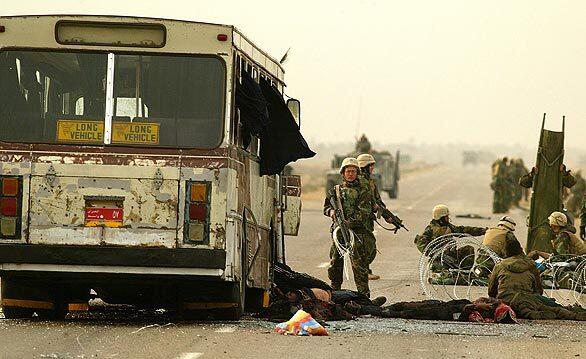
U.S. Marines stand over the scene of an attack on a bus believed to have been carrying fighters into southern Iraq. In the background, the wounded get medical care. Hussein’s personal paramilitary groups ambushed supply columns, organized resistance and kept a tight grip on Basra, the south’s main city.
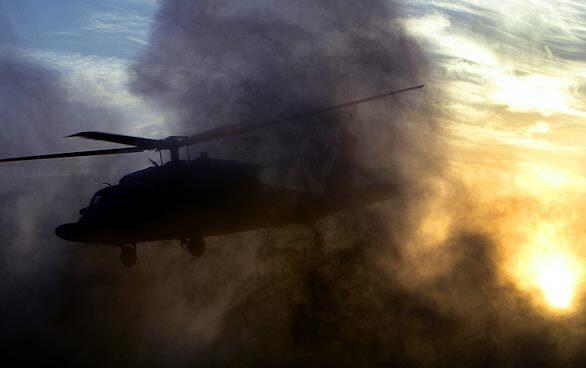
A U.S. Black Hawk takes off against the sunset, sending billows of sand into the air. The sand made takeoffs and landings, as well as routine maintenance, more difficult. Marines broke through the Republican Guard’s Baghdad Division south of the capital, and the U.S. military death toll reached 46. (Kevin P. Casey / Los Angeles Times)
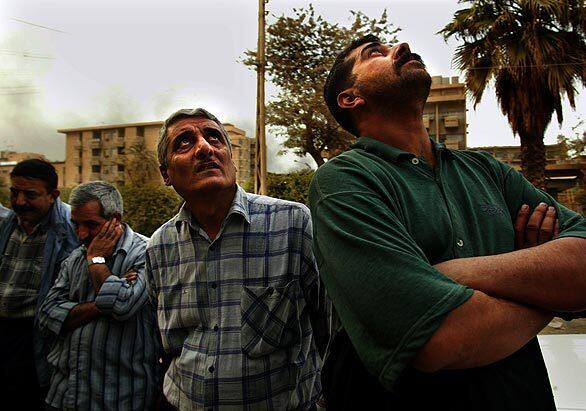
Baghdad residents, who say they will never accept the American invaders, watch as a U.S. B-52 bomber flies over the capital, where Hussein’s presidential complexes along the Tigris River were repeatedly bombarded. The strongman’s spokesman issued a TV message urging the public to rise up against U.S. forces. (Carolyn Cole / Los Angeles Times)
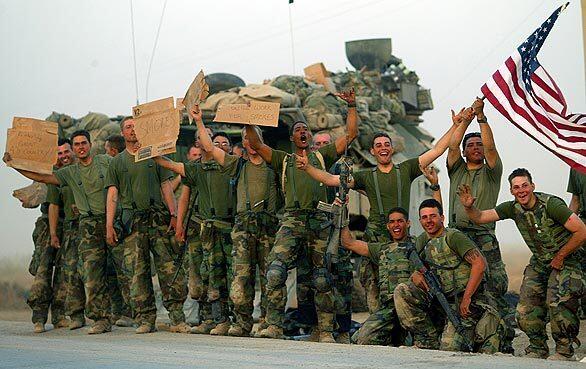
Marines wave and cheer a convoy of U.S. troops as it passes their position south of Baghdad. They were waving signs asking the troops for cigarettes, which, to the consternation of many, were in short supply. The day before, U.S. forces captured a major prize, Baghdad’s international airport. (Rick Loomis / Los Angeles Times)
Advertisement
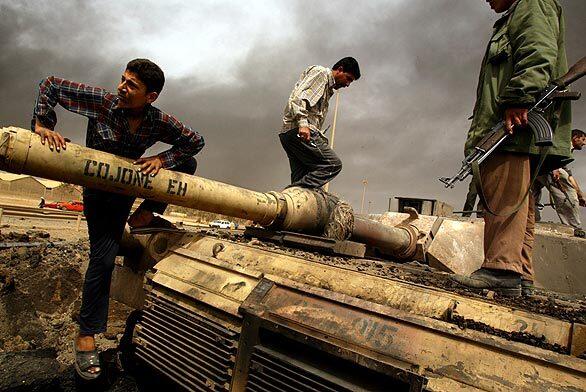
Iraqi soldiers and civilians climb on top of an American tank disabled in fighting a day earlier in a southern suburb of Baghdad. Some tried to break off pieces of the tank, likely abandoned by U.S. forces, as trophies. A column of about 60 tanks with the Army’s 3rd Infantry Division advanced from the airport, thundering toward the city center and defeating a Republican Guard guantlet. Hundreds of Iraqi soldiers were reported killed and 30 antiaircraft batteries destroyed. (Carolyn Cole / Los Angeles Times)
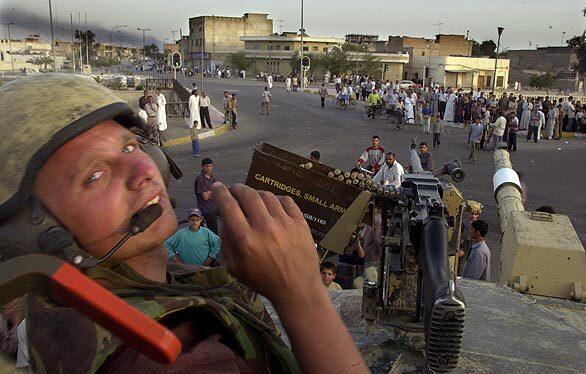
A gunner with the 7th Brigade of the British Royal Marines stands watch over Algeria Square in Basra, in southern Iraq. Curious residents were generally friendly toward the British troops as they forced their way into the city center, the deepest incursion yet in the two-week battle for Iraq’s second-largest city and main port. (Don Bartletti / Los Angeles Times)
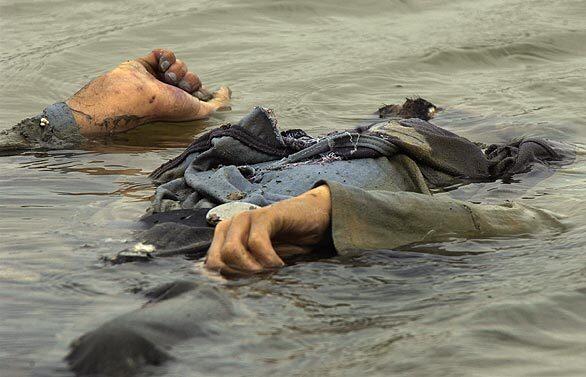
The body of an Iraqi irregular soldier floats in a marsh in Basra. Red Crescent volunteers retrieved the bodies of soldiers slain in fighting with British troops. British paratroopers entered the city on foot and frenzied looting broke out as residents grew more confident that Saddam Hussein’s rule was over. (Don Bartletti / Los Angeles Times)
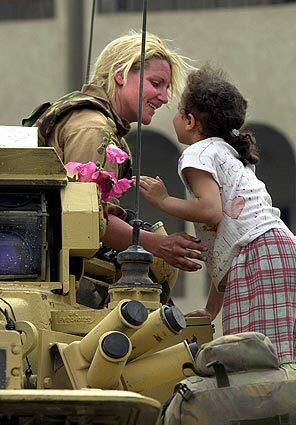
Crowds mobbed British marine tank units at they took Basra, and Capt. Sarah Shepherd became the darling of residents, for whom a female soldier was an uncommon sight. They gave her flowers, requested her autograph, and some asked for her hand in marriage. (Don Bartletti / Los Angeles Times)
Advertisement
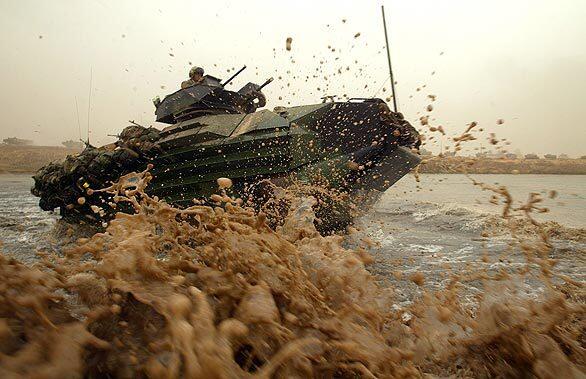
Marines cross the Diyala River on the edge of Baghdad to join the battle. U.S. troops captured one of Hussein’s presidential palaces, attacked another and blew up one of his statues as they rolled into the isolated, faltering capital. (Rick Loomis / Los Angeles Times)
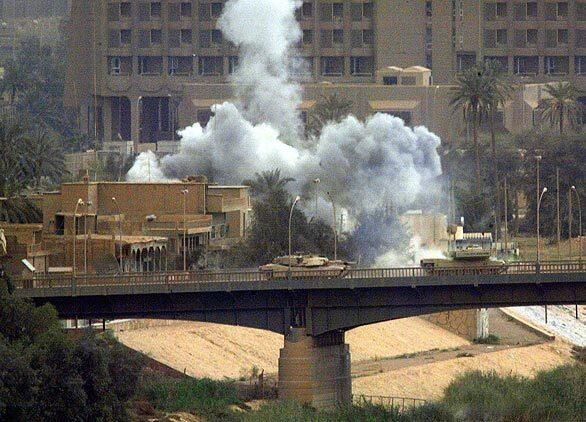
Tanks advance on Baghdad across one of the main bridges in Baghdad as aerial bombardment of the capital continues. Said one U.S. commander, “We hold the city and all major instruments of power. The regime is no longer in power.” (Carolyn Cole / Los Angeles Times)
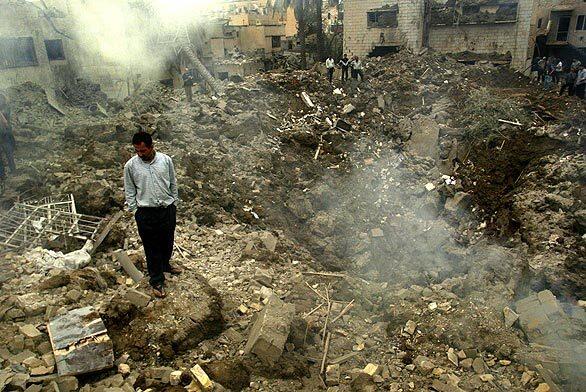
A large bomb landed in the Mansour neighborhood of Baghdad, flattening four houses. It was rumored to be the site targeted by a U.S. warplane that dropped four powerful bunker-busting bombs on a tip that Hussein and his sons Uday and Qusai had been there during the day.
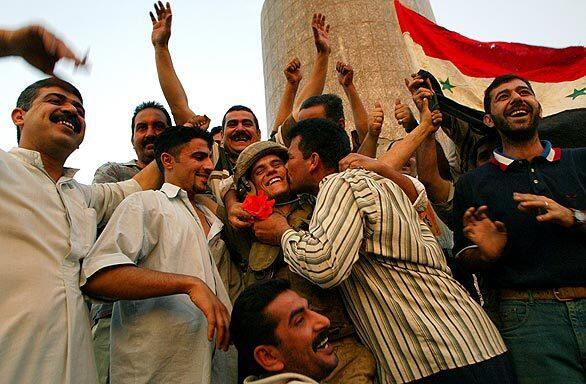
Marine Lance Copl. Shawn Hicks of Arizona gets a kiss from an Iraqi man as Baghdad residents celebrate the arrival of American troops in Firdos Square, in the heart of the capital. “Victory! We are free!” crowds called out. “Thank you, President Bush!”
Click here to see the Times’ front page from April 10, 2003, announcing U.S. control of Baghdad.
Advertisement
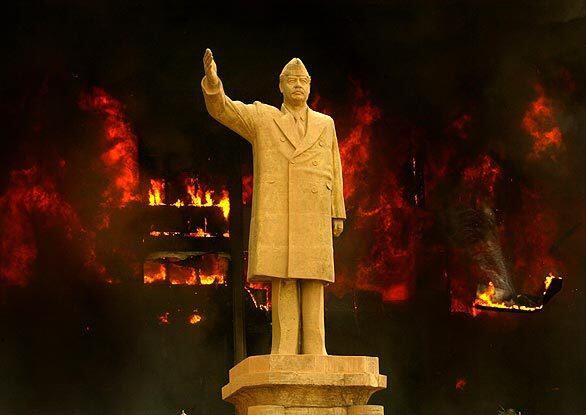
With Baghdad in U.S. hands, there were wild celebrations, but also widespread looting across the capital. The looters set fire to the headquarters of Iraq’s Olympic Committee, near a statue of Hussein. Government buildings across Baghdad were stripped of anything that could be carried. U.S. troops did not intervene. (Carolyn Cole / Los Angeles Times)
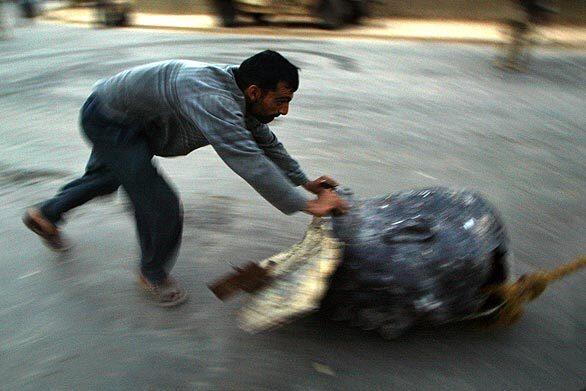
Baghdad residents broke and dismantled the numerous statues of Saddam Hussein that dotted the capital. A man rolls away the head from one of them. Many Iraqis spoke of how they detested the regime. (Carolyn Cole / Los Angeles Times)
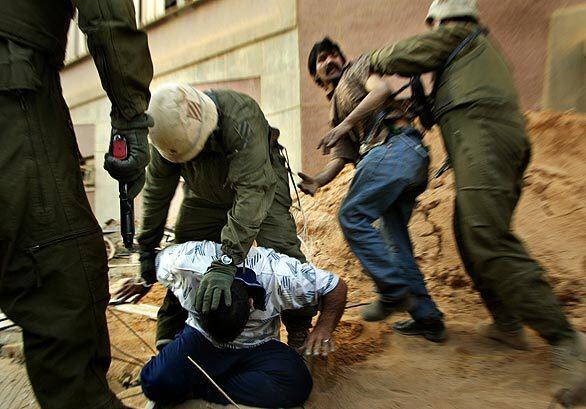
U.S. soldiers confront two men at a ministry building in Baghdad that was overrun by looters. “Stuff happens,” said U.S. Defense Secretary Donald Rumsfeld. “Freedom’s untidy. And free people are free to make mistakes and commit crimes and do bad things.” (Carolyn Cole / Los Angeles Times)
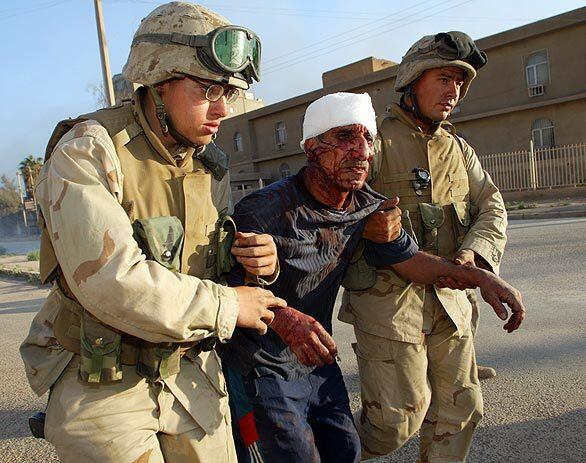
Marines help Ibrahim Elias, 53, walk to Red Cross headquarters in Baghdad. Elias, who was guarding a business, was shot and beaten by looters; the first hospital he went to had been ransacked. After several days of anarchy, U.S. troops moved to establish order and recruit Iraqis for joint patrols. (Bryan Chan / Los Angeles Times)
Advertisement
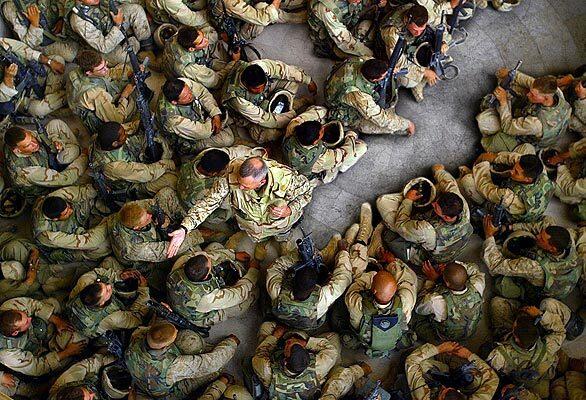
Marine commander Lt. Gen. Earl B. Hailston wades through a crowd of Marines in the lobby of a building captured in east Baghdad. Hailston congratulated them on their victory but warned that there was still much to be done. To the north, allied warplanes bombed Hussein’s hometown, Tikrit. (Rick Loomis / Los Angeles Times)
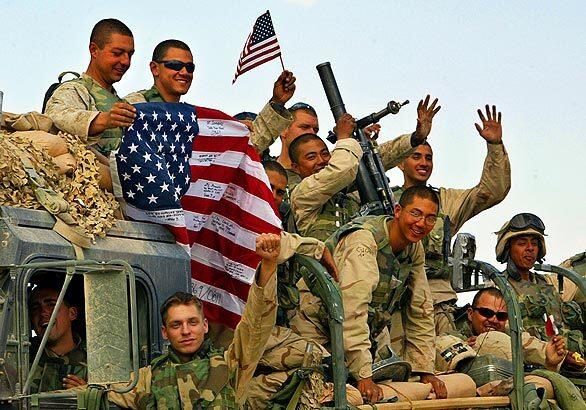
U.S. Marine reservists from Los Alamitos, Calif., celebrate after the capture of Tikrit, considered Hussein’s last stronghold; they faced little resistance in the end. With the fall of Tikrit, Maj. Gen. Stanley A. McChrystal, vice director of operations for the Joint Chiefs of Staff, declared, “The major combat operations are over.” (Carolyn Cole / Los Angeles Times)
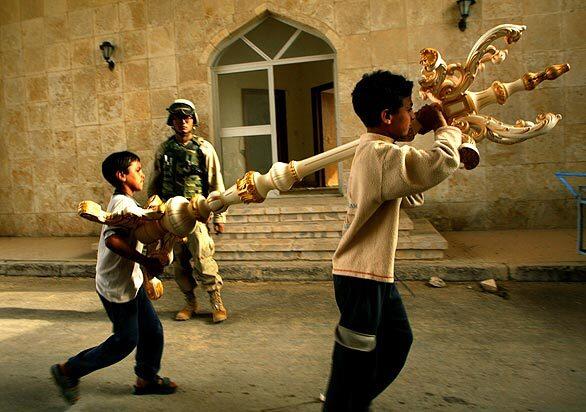
Looting breaks out in Tikrit after Marines took control of the city, and two boys make off with a hat rack from one of Hussein’s palaces. The Marines established part of their headquarters in one of the palace ballrooms, amid marble walls, golden fixtures and chandeliers. Most of Hussein’s Republican Guard fled north, damaging bridges as they retreated (Carolyn Cole / Los Angeles Times)
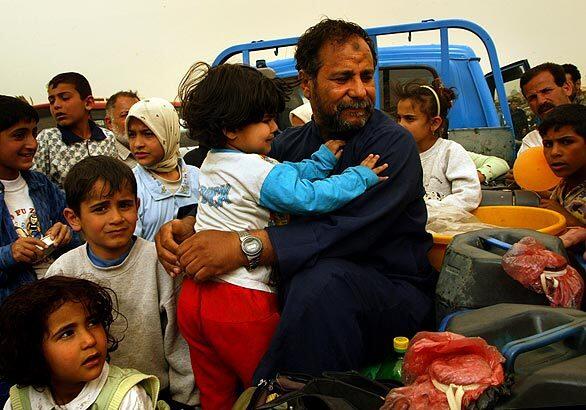
Families make their way back to Bagdhad as violence appears to have eased. Residents arrived crammed inro open trucks, buses, ard cars, many not knowing whether their homes were still standing. Some were angry about the state of the city and the lack of security. President Bush “doesn’t stop the looting, he only protects the oil,” said one. (Carolyn Cole / Los Angeles Times)
Advertisement
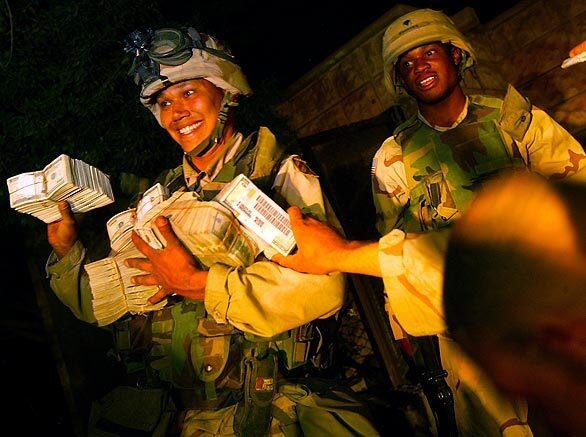
Army Spc. James May and Spc. Lawrence Edwards marvel over a portion of the estimated $650 million found stashed in hastily bricked-over cottages in a Baghdad neighborhood. “Assets belonging to Saddam Hussein and his cronies will be returned to the Iraqis,” U.S. officials said. (Rick Loomis / Los Angeles Times)
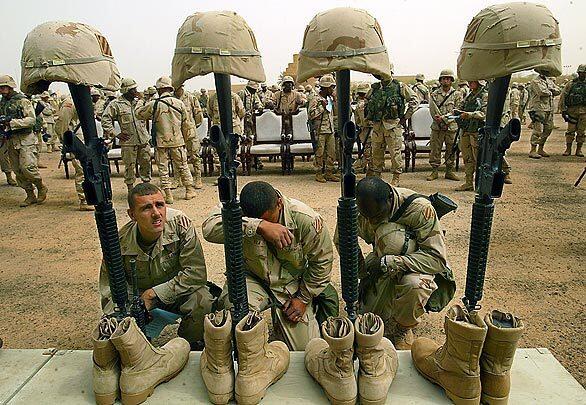
U.S. soldiers pay respects to fallen comrades after a service at the Iraqi National Parade Field to honor eight soldiers of the 2nd Brigade of the 3rd Infantry Division and three journalists who died in the U.S. war. By then, 134 U.S. troops and 13 journalists had been killed. The Bush administration urged patience as the military hunted for Hussein’s weapons of mass destruction. (Rick Loomis / Los Angeles Times)
